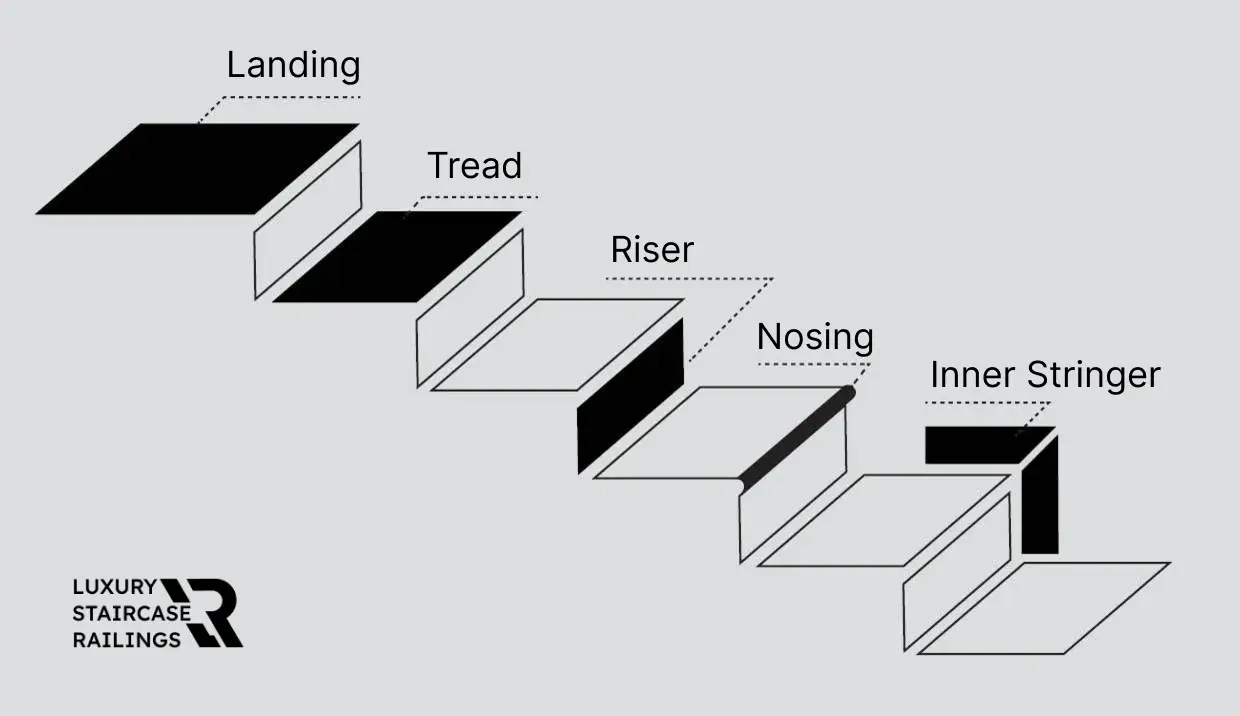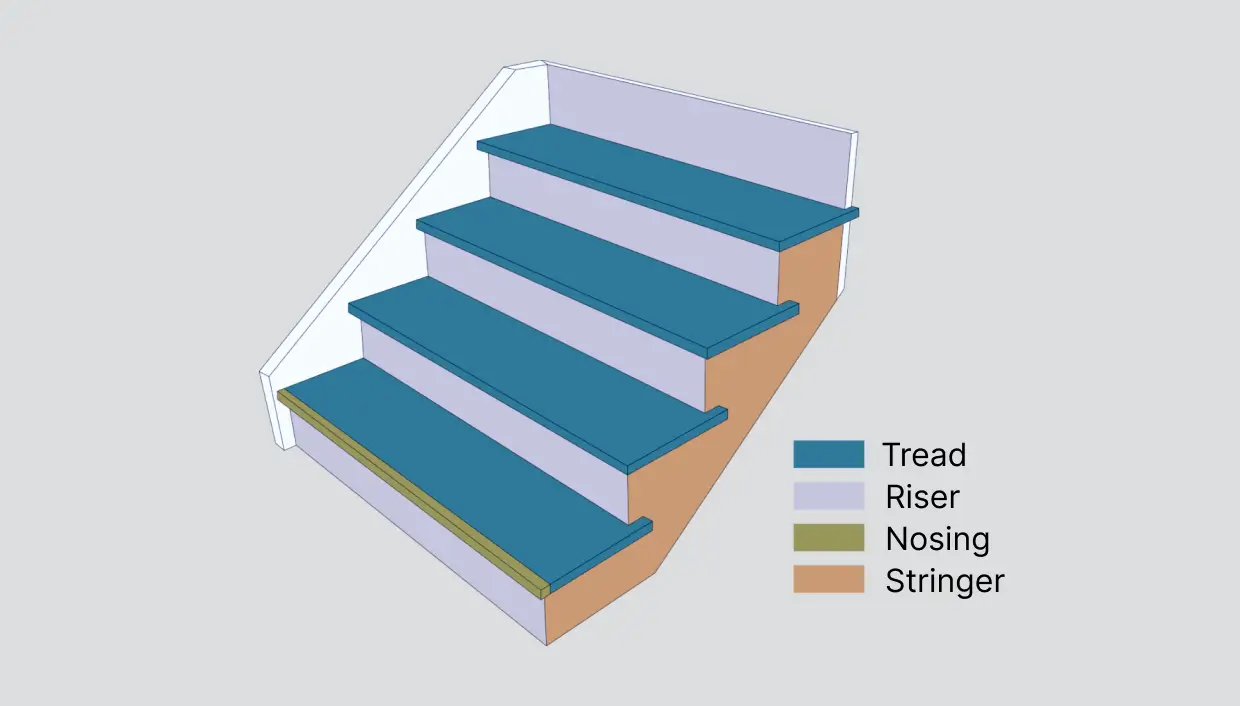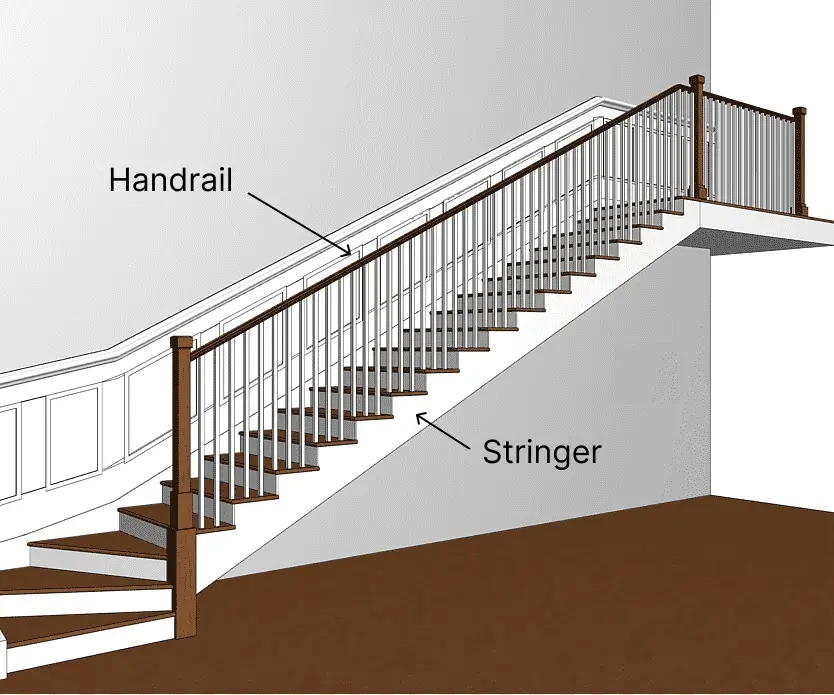
What Are the Parts of the Staircase Called?
A staircase does far more than connect different levels in a building; if it’s designed and engineered right, it can look like a suitable part of the interior. By understanding the parts of stairs that together build a staircase, you will create something that fits your home or commercial space. By observing parts of a staircase and knowing that each of them plays an important role you will appreciate the intricacy of its construction and the thoughtfulness behind its design.

Basic Stair Components
Staircases are made of several important parts of staircase that together make safe and efficient passage. Understanding these components is important for anyone interested in stair design, construction, or home improvement. The foundation of any staircase is formed by its basic components. What does this foundation include?
Stringer
One of the first among all the stair parts names is stinger. It is not just the main support frame hiding under the stairs, the stringer is essential because it carries most of the weight whenever you go up or down. Exposing it can add a stylish, architectural element to your space, creating a distinct line that traces each step from the top down to the bottom.
Tread
One of the main components of stairs is Tread. They’re not just flat pieces of wood or metal; they need to be sturdy and well-built to last a long time. The depth and width of treads are carefully planned to fit the staircase’s design and to make sure they’re comfortable to walk on. The horizontal platform of each step, treads must be designed to withstand constant foot traffic. They vary in depth and width depending on the type of staircase and are sometimes finished with materials to match the flooring of a building for visual continuity.
Stair Nosing
Another among the names of stair parts list is Stair Nosing. It’s the part that sticks out a bit at the front of each tread and it’s crucial because it gives you extra space to place your foot, reducing the chance of slips and trips. It’s like the front bumper for each step, taking the hit of heavy traffic to protect the rest of the tread.
Riser
Risers is one on the stairs parts names list that give your stairs their classic look by filling in the gap between each tread. But when they’re left out, you get that cool floating staircase effect that can make a room feel more spacious. The design choice between solid and open risers can dramatically change not just the look, but also the feel of the staircase, influencing how light and sound move through the space.
Newel
One of the main stair components names are newel posts. These are the strong pillars that you see at the bottom and sometimes at the top of the stairs. They help hold up the handrail and the balusters—that’s the row of posts connected by the handrail. These posts can look really simple or very fancy, with lots of cool designs, depending on what the stairs look like.
Newel Cap
Newel caps is a key stairs parts name that serves as the crowning feature of a staircase’s newel post. They come in a variety of shapes, from pyramidal to spherical, and can be as simple or as ornate as one wishes. Newel caps may mirror the architectural details of the space, such as matching a geometric pattern from the room’s crown molding or echoing the contours of the fireplace mantel. This kind of design continuity helps to unify the architectural elements of the home. Newel caps can be crafted from a range of materials including metal, glass, or stone. They might also be functional, designed to provide a smooth hand-off from the handrail to the newel post.
Landing
More than a mere resting point, landings are a basic components of a stairway that can be designed as a grand platform, setting the stage for a change in direction or the final approach to the next floor. They can also provide a space for decorative elements such as a window seat or display area.
Handrail
Handrail won’t be left on the stair part names list. Beyond their practical use, handrails are a design element that flows along the staircase. They can be simple for utilitarian purposes or beautifully carved or formed.
Baluster
Also known as spindles or stair sticks, balusters are the vertical components of a staircase that connect the tread to the handrail. They can be straightforward for a minimalist aesthetic or designed for a more opulent look.
Read also: How To Choose the Right Material for Your Railing System
Other Stair Components
Aside from these basic elements, staircases often feature additional components that enhance their functionality and aesthetics. Whether simple or intricate, the parts of a staircase work together to ensure stability, comfort, and style. Let’s explore the staircase parts names and the additional elements that can make a staircase more than just a functional necessity, but a statement piece within a home or building, possibly involving a railing company for specialized design and installation.
- Bullnose: the first additional element in stair terminology is the starting step with a rounded edge that often protrudes beyond the stringer on one or both sides.
- Winders: steps that are narrower on one end, used to change the direction of the stairs without the need for a landing.
- Volute: a handrail end element that spirals elegantly, typically found at the bottom of the stairs.
- Turnout: a small curved rail at the beginning or end of the handrail that wraps around the starting newel.
- Gooseneck: the part of the handrail that joins a lower run to a higher one at a landing, often incorporating a vertical turn.
- Rosette: a decorative piece affixed to the wall where the handrail ends or at points of transition.
- Easing: a section of the handrail that smoothly changes direction or pitch, creating a comfortable grip transition.
- Trim: the finish molding applied where the stairs meet the wall, enhancing the staircase’s aesthetics and hiding gaps.
- Finial: a decorative cap that sits atop newel posts, finials are the crowning detail that can express personal style and elegance.
- Fillet: a small strip of material filling the space between balusters or under the handrail.
- Flutes: grooves cut into the vertical face of the baluster, flutes add texture and decorative detail to the staircase.
All these parts of a stair railing not only serve a structural or functional purpose but also contribute to the overall design, making staircases a significant architectural feature in many buildings.
Read also: Popular Stair Tread Covers
-
Erika Baldwin was born in Bogotá, Colombia, and graduated from Liceo Boston in 2000. She studied Design at Universidad Nacional de Colombia. Starting her career as a model in 1998 with agencies in Colombia and Miami, Florida, Erika later transitioned to real estate, working with EWM Realtors, Prudential Realty, Berkshire Hathaway HomeServices with the Denise Rubin Group, and Isler Realty. She currently holds a real estate license with Century 21 in Wellington, Florida. As the General Manager of Luxury Staircase Railings, Erika is passionate about creating handrail systems that go beyond functionality — designed to reflect the unique style and character of every building. She works closely with her clients to bring their visions to life, ensuring each project is tailored to their specific needs. For handrails that combine safety with elegant design, Erika Baldwin is the trusted expert.
View all posts








